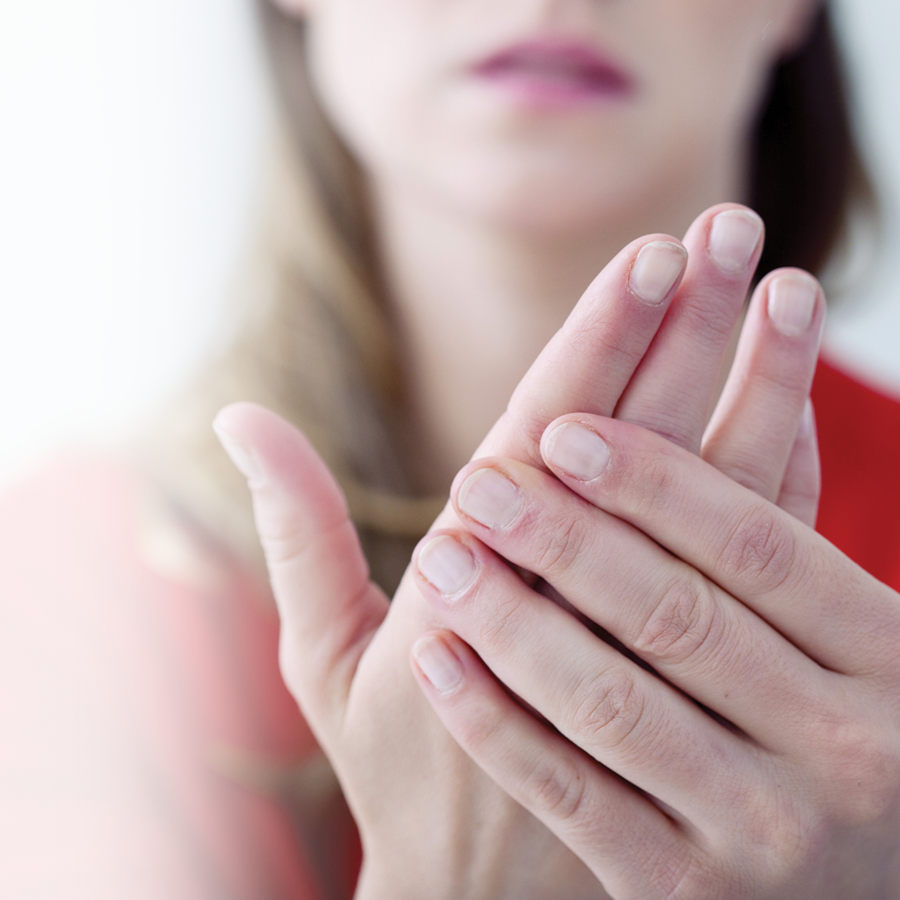Everyone has gone outside in the cold at some point without gloves and a scarf. For people with Raynaud's disease, this can trigger an attack.
Raynaud's disease
Is there a person in your life whose fingers become very white when they are exposed to the cold? This is probably the best known manifestation of Raynaud's disease. It is caused by the contraction or narrowing of very small blood vessels, called arterioles, which carry blood to the extremities and other parts of the body, including the:
- fingers
- toes
- ears
- nose
- lips, and
- nipples
In medical terminology, the term “vasoconstriction” is used to refer to the narrowing of blood vessels. For individuals affected by Raynaud’s disease, vasoconstriction is excessive and abnormally decreases blood circulation. It occurs especially during exposure to certain factors such as:
- the cold
- a drop in temperature, such as that experienced when passing through an air-conditioned room or into the frozen food section of the grocery store
- stress, and
- an emotional shock
Raynaud’s disease affects between 3% and 5% of the adult population, women being more affected by it.
Signs and symptoms of Raynaud’s disease
The signs and symptoms of this disease develop in three phases. After exposure to a trigger, significant paleness or whiteness of the affected part of the body is observed. Loss of sensitivity may be felt, and the skin becomes cold.
Subsequently, a significant decrease in blood flow causes cyanosis; a bluish discoloration of the skin. Next, the restoration of blood flow manifests itself by a reddening of the affected area about 15 to 20 minutes after the end of the exposure to the element which caused the attack.
Raynaud’s disease can also cause:
- pain
- stinging
- tingling, and
- numbness
When they occur in the hands, attacks usually begin with the index finger, the middle finger, or the little finger, then spread to the other fingers. The thumb is rarely affected. Attacks can last from a few minutes to a few hours.
The causes of Raynaud’s disease
There are two types of this disease, with different causes. This distinction is important because it influences the proposed treatment option.
Primary Raynaud’s disease mostly affects people in good health. It represents more than 80% of cases. The first episode usually occurs before the age of 30. Complications are rare and periods of remission are common. Its cause is still unknown.
The secondary form of the disease is called Raynaud’s phenomenon or Raynaud’s syndrome. It is called secondary because there is an underlying cause, such as an adverse drug reaction or a disease that causes a problem with blood flow such as:
- scleroderma
- lupus erythematosus
- Sjögren’s syndrome
- atherosclerosis
- rheumatoid arthritis
- etc.
The signs and symptoms of Raynaud’s syndrome are the same as the ones previously described. However, they can be more severe and last longer.
Non-pharmacological measures
The first step of treatment for Raynaud’s disease consists of implementing non-pharmacological measures, particularly focused on changing certain habits. These measures may be sufficient to treat mild cases.
Here is some advice on the subject:
- Quit smoking. Smoking causes blood vessels to narrow and promotes the onset of an attack.
- Reduce your alcohol and caffeine intake (tea, coffee, and colas).
- Avoid using medications which cause blood vessels to contract, such as decongestants and certain agents used to treat migraines or attention deficit disorder with or without hyperactivity (ADHD).
- Always speak to your pharmacist before taking medication. They can guide you to some safe choices, especially when it comes to over-the-counter medication.
- Learn to master certain relaxation techniques, especially if your attacks are caused by stress or emotions.
- Avoid the cold. Wear warm gloves and socks.
- Dress in layers; wear several layers of clothing.
- Avoid varying temperatures, such as the transition from a warm place to an air-conditioned one.
- Limit the use of tools that cause vibrations.
When an attack occurs, soak the affected area of the body in warm water to help restore blood circulation. You can also place your fingers under your armpits or rub them together gently to warm them up.
Treatments
If the attacks are not under control using non-pharmacological measures, your doctor can prescribe medication. Some individuals will only have to take them when needed during the winter months; others, particularly those who are affected by a more severe form, will have to take the medication regularly for a more stringent therapy.
All therapies are intended to promote blood flow and prevent the excessive narrowing of blood vessels. Your pharmacist can advise you so that you can make optimal and safe use of the prescribed treatment.
Don’t hesitate to speak to your pharmacist for additional information about Raynaud’s disease.

